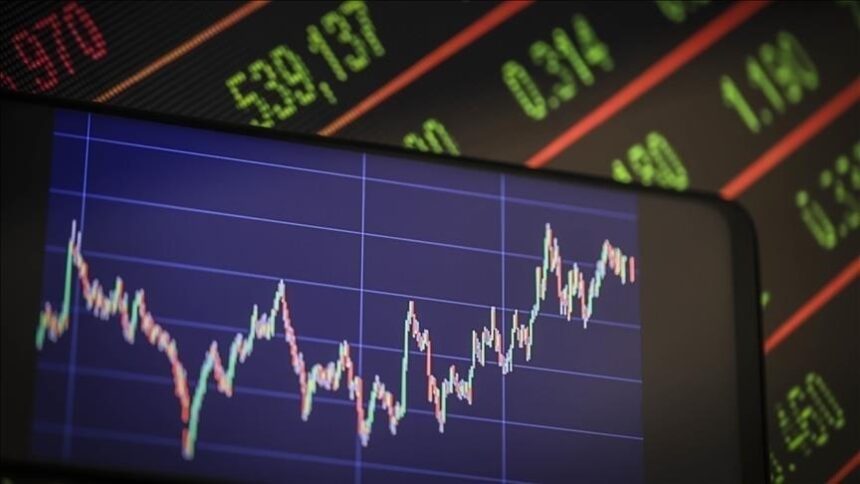The U.S. stock market has shown a remarkable recovery following a sharp downturn sparked by the trade tensions between the U.S. and China. After a rally, stocks are nearing record highs, but there are concerns that the momentum may slow in the near term. Investors are wary of the lingering effects of tariffs and higher equity valuations, which could dampen further gains.
The S&P 500, a key benchmark for the U.S. stock market, has surged 18% since its lowest point this year on April 8, recovering all the losses it suffered in 2025. The index now stands just 4% away from its all-time peak reached in February. However, while the market has rebounded strongly, analysts are cautioning that the price-to-earnings (P/E) ratio for the S&P 500 has reached a two-month high. Furthermore, profit growth projections for U.S. companies have been downgraded since the start of the year.
Although the U.S. has reduced some of the tariff burdens, concerns remain over the impact of the remaining import levies on corporate profits and consumer spending. These tariffs continue to put pressure on the economy, raising uncertainty among investors.
“The momentum is very strong, so it could carry markets up here,” said Anthony Saglimbene, chief market strategist at Ameriprise Financial. “But I think for markets to maintain those levels, it is going to be difficult because the environment is still uncertain.”
Read More: UAE Air Industry Soars with Etihad’s $14.5B Boeing Deal
US Stock Market Volatility
The recent market rebound follows U.S. President Donald Trump’s announcement of a temporary truce in the ongoing trade war with China. On April 2, Trump’s global tariff plan caused significant market volatility, sending stocks into a downward spiral. However, the situation has since improved with the announcement of a 90-day truce between the two largest economies, which led to a reduction in tariffs from over 100% on both sides.
The effective U.S. tariff on imports has decreased to 14% from a previous 24%, according to JPMorgan economist Michael Feroli. While this reduction has provided some relief, it remains significantly higher than the 2.3% tariff rate in 2024. Feroli cautioned that while the lower tariffs might ease some pressure, they would still contribute to inflation, ultimately reducing consumer spending power.
“Although the tariff reductions are positive, they are still a drag on the economy,” said Feroli in a report. “These lower tariffs could continue to put pressure on disposable income and consumer spending.”
As the first-quarter earnings season winds down, U.S. companies have reported earnings above expectations. However, analysts have revised their full-year earnings projections downward, now expecting an 8.7% increase in profits, compared to an earlier forecast of 14%. This adjustment has raised questions about the sustainability of the stock market rally.
“We’ve seen valuations make a round trip while earnings estimates have come down,” said Angelo Kourkafas, senior investment strategist at Edward Jones. “Further gains are going to be harder to come by in the short term.”
Also Read: Rents on Al Marjan Island Soar by 60% in Two Years Due To Rising Demand
This week, the S&P 500’s forward P/E ratio, based on earnings projections for the next 12 months, rose above 21 for the first time since early March. This is significantly higher than the index’s long-term average of 15.8 and up from 17.9 at the market lows in April. This rise in valuations has prompted caution among some investors.
“After such a massive rally, I’m not sure I would chase the stock market here,” said Chris Galipeau, senior market strategist at Franklin Templeton. “The risk/reward right now is not as favorable.”
UBS Global Wealth Management echoed similar concerns, downgrading U.S. equities to a “neutral” rating from “attractive.” They noted that while the market rally is impressive, the economy will need to adjust to the higher tariffs, potentially leading to weaker economic data that could act as a headwind for stocks.
Despite these concerns, some investors have turned more optimistic about the market’s prospects, particularly following the U.S.-China trade truce. Analysts at Goldman Sachs and Yardeni Research raised their year-end targets for the S&P 500, with Yardeni predicting a target of 6,500, which represents a 10% increase from current levels.
The probability of a U.S. recession in 2025 has decreased significantly, with online prediction markets such as Polymarket lowering the chances to around 40% from 66% at the beginning of May.
However, King Lip, chief strategist at BakerAvenue Wealth Management, cautioned that the rally could be overstretched. “In the short term, the rally seems a little extended,” Lip said. “It seems like people believe they got the all-clear signal, but I’m not sure it’s all clear just yet.”
In The End
The market moves forward, all eyes will be on upcoming economic reports and the ongoing impact of tariffs. While the rebound has been impressive, the near-term outlook remains uncertain, with potential headwinds ahead for the stock market.
Click here for more business news.






